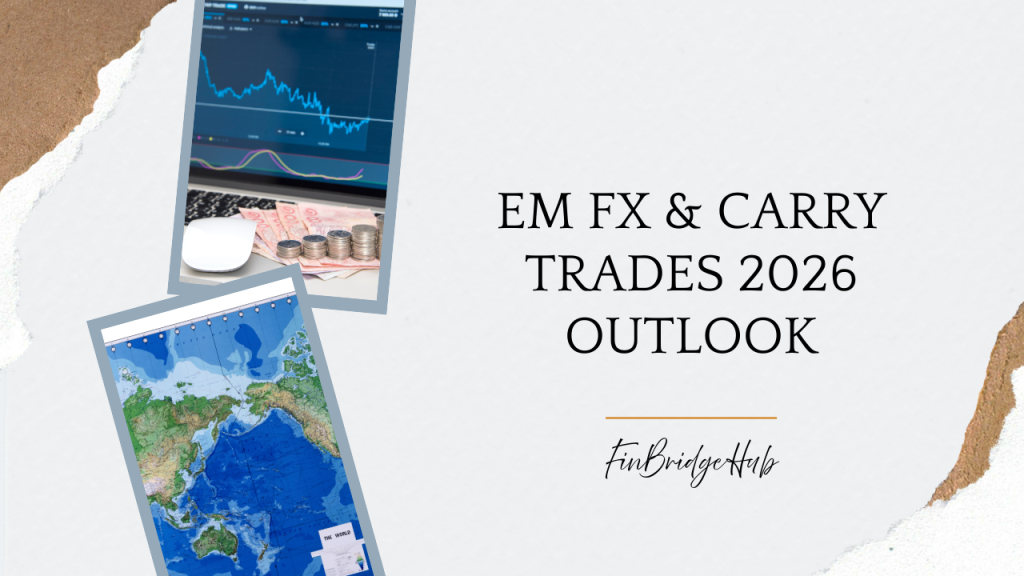
Navigating 2026: Selective FX Opportunities Ahead
Foreign exchange markets in 2026 will be defined by transition. With the U.S. Federal Reserve expected to begin a gradual easing cycle, pressure on EM currencies should lessen. However, dispersion between high-yield carry currencies and structurally weaker peers will widen.
Investors must approach 2026 FX markets with a barbell strategy: overweight stable high-carry currencies with strong fundamentals, while avoiding fragile currencies exposed to policy or geopolitical risk.
Global Macro Backdrop for FX in 2026
U.S. Dollar Outlook
- USD strength peaked in 2025.
- Fed rate cuts of ~75–100bps expected during 2026.
- Dollar may soften, but remains resilient due to safe-haven flows.
EM Currency Landscape
- Higher real yields in EM compared to DM attract inflows.
- Strong commodity exporters (Brazil, Mexico, Indonesia) favored.
- Fragile sovereigns (Turkey, Argentina, Nigeria) remain under pressure.
Top Carry Currencies for 2026
Mexican Peso (MXN)
- Still the top carry trade currency globally.
- Benefiting from nearshoring and strong integration with U.S. economy.
- MXN expected to remain resilient even during global risk-off episodes.
Indian Rupee (INR)
- Supported by strong growth, digital finance flows, and stable inflation.
- RBI credibility anchors investor confidence.
- INR volatility remains low relative to other EM peers.
Indonesian Rupiah (IDR)
- Attractive yields supported by nickel exports and fiscal stability.
- Risks include current account balance and external funding needs.
- Still a high-beta currency for global carry strategies.
Secondary Opportunities
Brazilian Real (BRL)
- Volatile but attractive when commodities rally.
- Fiscal credibility a swing factor.
South African Rand (ZAR)
- High yields, but political risks and power shortages weigh.
- Suitable only for tactical allocations.
Korean Won (KRW)
- Not a carry trade, but provides stability within Asia.
- Sensitive to Fed policy and China’s growth.
Interim Insights (Mid-2026 View)
- The carry trade environment is favorable due to Fed easing and stable EM inflation.
- MXN, INR, and IDR remain the most attractive core allocations.
- Commodity-linked currencies (BRL, CLP) offer tactical plays.
- Fragile currencies (TRY, ARS, NGN) should be avoided for strategic allocations.
Risk Scenarios for EM FX in 2026
- Delayed Fed Easing
- If inflation proves sticky, USD strength could reassert, hitting high-beta EM currencies.
- China Growth Weakness
- Commodity exporters (BRL, CLP, ZAR, IDR) vulnerable to weaker Chinese demand.
- Geopolitical Tensions
- Escalations in the Middle East or South China Sea may drive safe-haven USD flows.
- Domestic Policy Missteps
- Turkey (TRY) and Argentina (ARS) face high risk from inconsistent policy.
Investment Strategy Recommendations
- Core Carry Trades
- Overweight: MXN, INR, IDR.
- Hedge with selective USD long positions.
- Tactical Commodity Plays
- BRL, CLP, ZAR when global commodity cycles are strong.
- Stability Anchors
- KRW, SGD, and GCC pegs for portfolio diversification.
- Avoid Fragile Currencies
- TRY, ARS, NGN remain vulnerable to policy inconsistency and capital flight.
Portfolio Construction Ideas
- Balanced FX Carry Portfolio (2026)
- 40% MXN (structural nearshoring + carry)
- 25% INR (growth + stability)
- 20% IDR (high carry, commodity link)
- 15% Tactical BRL/ZAR allocations
- Risk-Hedged Strategy
- Long MXN/INR vs Short TRY/ARS as relative value play.
- Use KRW or USDJPY as hedge during risk-off.
Key Takeaways for 2026 EM FX
Emerging Market FX in 2026 offers one of the most attractive carry environments in years. However, investors must be selective: structural winners like MXN, INR, and IDR are likely to outperform, while fragile currencies should be avoided. Hedging with KRW, SGD, or pegged GCC currencies provides diversification.
Leave a Reply